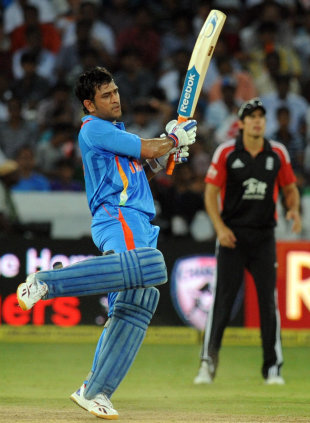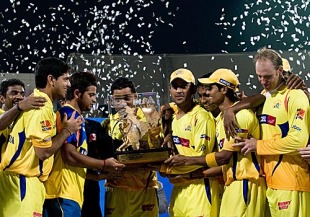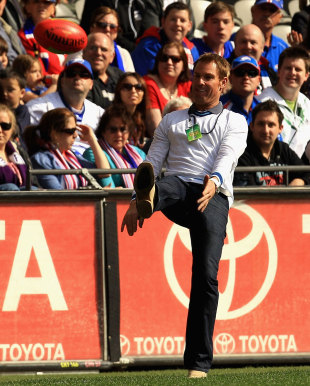India 300 for 7 (Dhoni 87*, Raina 61) beat England 174 (Cook 60, Jadeja 3-34) by 126 runs
Scorecard and ball-by-ball details
Scorecard and ball-by-ball details

| ||
MS Dhoni marked India's homecoming with a brutal innings of 87 not out from 70 balls, before the left-arm spin of Ravindra Jadeja sparked a dramatic English batting collapse, as the team that failed to win a single international fixture on their recent tour of England returned to form with a crushing 126-run victory at Hyderabad.
Dhoni's performance was his fourth half-century in as many international innings, but whereas the last three had been insufficient to force victory, this performance was more reminiscent of his last performance in a home international - his crushing 91 not out in the World Cup final against Sri Lanka in April.
After winning his first toss in six attempts against England, Dhoni chose to bat first on a slow surface, but India were struggling on 139 for 4 after 34 overs before he and Suresh Raina turned on the after-burners as a further 161 were added in the final third of the innings. As had regularly been the case in England, he started cautiously against a disciplined attack, and had reached 5 from 18 balls before belting his first boundary, from Ravi Bopara, to signal India's late charge.
In total, Dhoni belted 10 fours and one six in his innings, the latter coming from a trademark helicopter flick off Steven Finn in the penultimate over of the innings. Finn had started his day's work with impressive pace and accuracy, and should have had a first-over wicket when Jonathan Trott dropped a sitter off Ajinkya Rahane at second slip - a moment that only the 26,000 crowd were able to witness, thanks to a TV rights dispute that caused a three-over blackout. But Finn finished with the bruised figures of 1 for 67 in nine overs, with his solitary wicket that of Raina in his seventh over, moments after he had been battered for another six over long-on.
Raina, whose brutality against the full length ball was a sight to behold, crunched 61 from 55 balls, with both of his sixes coming from the final four balls of his innings. Like Dhoni, he had opted for circumspection in the early part of his stay, but the longer his 62-run stand for the fifth wicket continued, the more boisterous the Hyderabad crowd became.
It had been a more muted affair in the early part of India's innings. Parthiv Patel was run out at the non-striker's end for 9 as Finn fingertipped a Rahane drive onto the stumps, while Rahane himself had reached 15 from 41 balls when Graeme Swann dragged him out of his crease with his third delivery of the match to give Craig Kieswetter an easy stumping.
In his first match since recovering from concussion, Gautam Gambhir confirmed his fitness with a fluent 32 from 33 balls. However, Jade Dernbach's liquorice allsorts proved hard to pick and tough to get away on the surface, and the slower ball that did for Gambhir was a beauty. It looped up above the batsman's eyeline and dropped sharply to rap his shin in front of leg stump.
At 79 for 3 after 18 overs, the game was very much in the balance. However, England's position could, and probably should, have been even better after 25 overs, when Samit Patel repeated Finn's trick of dropping his fingertips on a straight drive. It was Raina this time who was in peril as the bails were dislodged, but after a lengthy delay for the TV adjudication, he was given the benefit of the doubt by the third umpire, Sudhir Ashani.
In the final analysis, however, it really didn't matter. Though Alastair Cook continued his impressive form as England captain with 60 from 63 balls, his dismissal in the 23rd over of the innings precipated a dramatic collapse at the hands of Jadeja and R Ashwin. England tumbled from 111 for 2 to 134 for 7 in the space of 40 balls, and only Samit Patel (16) and the No. 10, Finn, with a run a ball 18, provided any resistance.
Praveen Kumar, India's star bowler from their ill-fated tour of England, had launched India's defence in fine style, opening up with a maiden to Cook, and he had not conceded a run when he extracted Kieswetter with his eighth delivery, a full-length ball that jagged off the seam to take a thin edge through to Dhoni.
The loss of their top-order powerhitter caused England to rejig their conventional batting order, with Kevin Pietersen emerging at No. 3 ahead of the more staid Trott. The plan looked to be paying off as Pietersen launched his innings with ominous resolve, but having struck three fours in a 28-ball 19, he attempted a quick single to mid-on where Ashwin nailed him with a direct hit.
Trott then appeared at No. 4, and for 13.3 overs he and Cook steadied the innings, adding 71 for the third wicket to give England a solid platform. But then, having brought up his fifty at exactly a run a ball, Cook gave his innings away with a loose clip to deep midwicket off Ravindra Jadeja, and thwacked his pad with his bat in frustration as he left the crease.
Worse was to follow for England two overs later. Trott, whose 26 from 42 balls had been a typically measured performance, attempted an ungainly smear across the line against Jadeja and lost his leg stump, and eight balls later, Ravi Bopara drove loosely at Ashwin and chipped a simple return catch to the bowler.
Jadeja by now was on a roll with the crowd fully behind him, and he extended England's collapse to four wickets in 26 balls when Jonny Bairstow, the hero of the run-chase in Cardiff, last month, also offered up a return catch. His figures after four overs were 3 for 17, and England's unbeaten run against India in 2011 was soon all over.


